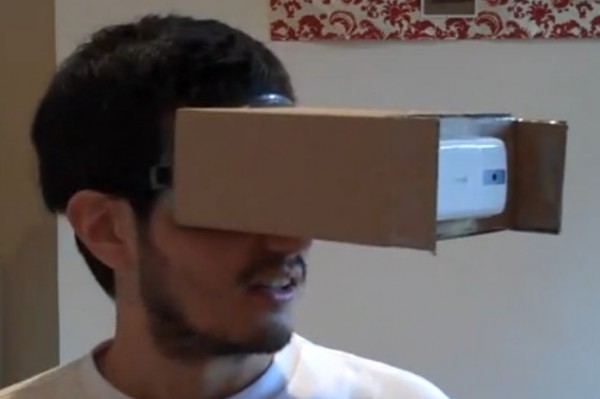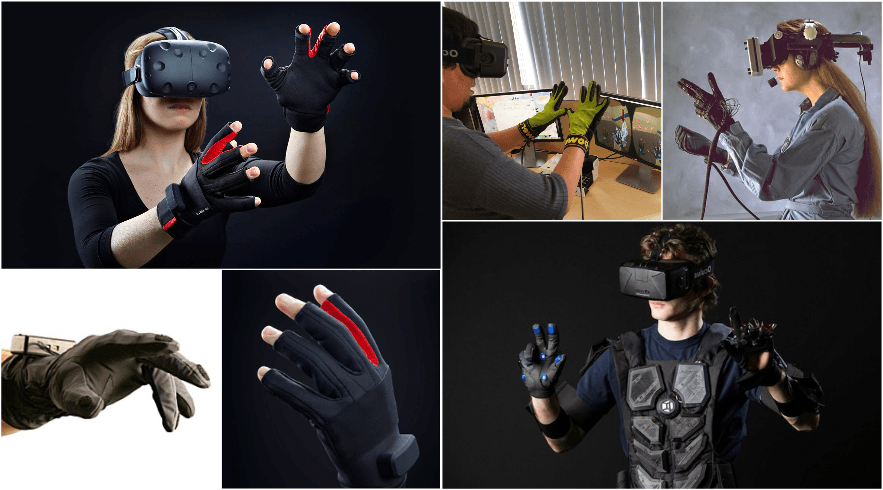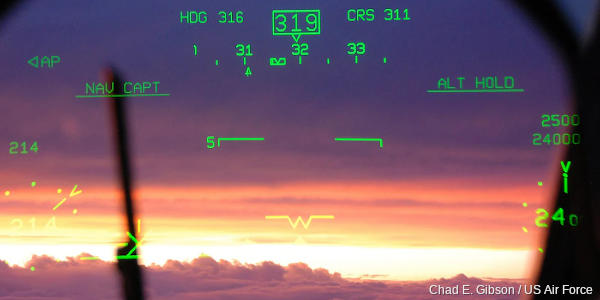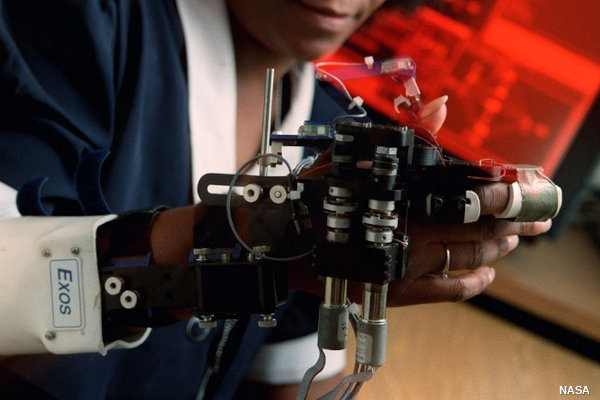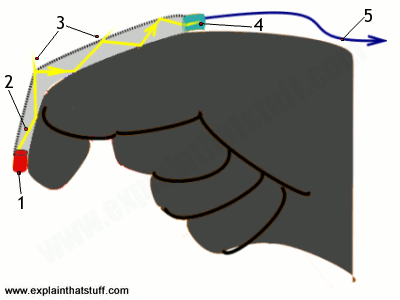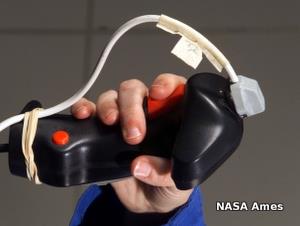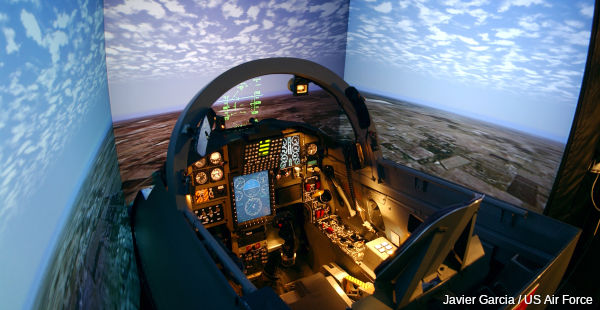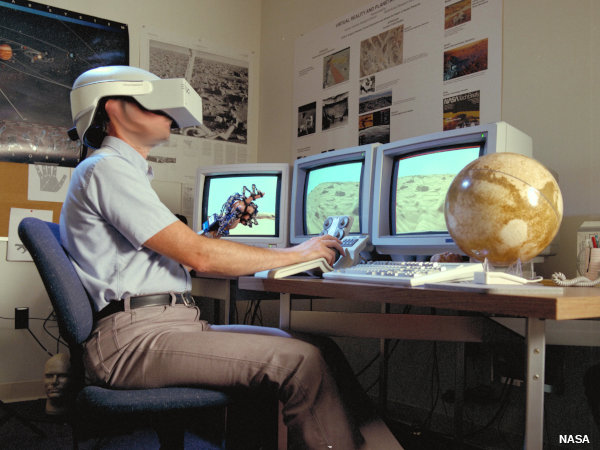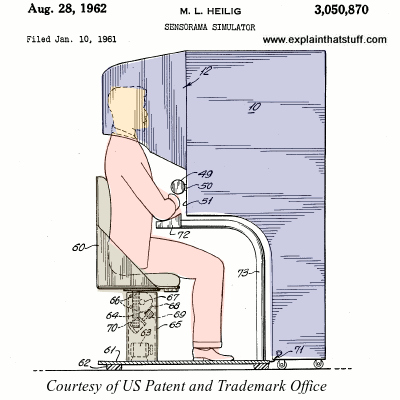What is virtual reality
What is virtual reality
Что такое виртуальная реальность: свойства, классификация, оборудование — подробный обзор области
В декабре мы писали о том, на какие тенденции в мире IT стоит обратить внимание в будущем 2017 году. Одним из пунктов обозначили виртуальную реальность, и не зря. Интерес к VR сильно вырос за последние 2–3 года и продолжает расти, появляется всё больше различного оборудования и технологий, а главное — новых идей, для реализации которых нужны разработчики.
В этой вводной статье мы поговорим о свойствах, типах и областях применения VR — это поможет лучше сориентироваться тем, кто хочет начать свой путь в развивающейся и актуальной сфере.
Виртуальная реальность — это генерируемая с помощью компьютера трехмерная среда, с которой пользователь может взаимодействовать, полностью или частично в неё погружаясь.
Свойства VR
Полный набор встретить можно редко, но ниже перечислены те особенности, на которые нужно ориентироваться при создании виртуальной реальности.
Типы VR
VR с эффектом полного погружения
Этот тип подразумевает наличие трех факторов:
VR без погружения
Не каждому и не всегда необходимо полное погружение в альтернативную реальность. К типу «без погружения» относятся симуляции с качественным изображением, звуком и контроллерами, в идеале транслируемые на широкоформатный экран. Также в эту категорию попадают такие проекты, как археологические 3D-реконструкции древних поселений или модели зданий, которые архитекторы создают для демонстрации своей работы клиенту. Все перечисленные выше примеры не отвечают стандартам VR в полной мере, но позволяют прочувствовать моделируемый мир на несколько уровней глубже, чем другие средства мультимедиа, а потому причисляются к виртуальной реальности.
VR с совместной инфраструктурой
Сюда можно отнести «виртуальные миры» вроде Second Life и Minecraft. Единственное свойство из перечисленного выше, которого им не хватает для полного комплекта — создание эффекта присутствия: такие миры не обеспечивают полного погружения (в случае с Minecraft это касается только стандартного управления — у игры уже существует версия для виртуальной реальности, поддерживающая шлемы Oculus Rift и Gear VR). Тем не менее, в виртуальных мирах хорошо прописано взаимодействие с другими пользователями, чего часто не хватает продуктам «настоящей» виртуальной реальности.
Виртуальные миры используются не только в игровой индустрии: благодаря таким платформам, как 3D Immersive Collaboration и Open Cobalt можно организовывать рабочие и учебные 3D-пространства — это называется «совместная работа с эффектом присутствия».
Создание возможности одновременного взаимодействия в сообществе и полного погружения сейчас является одним из важных направлений развития VR (вспомним тот же Minecraft).
VR на базе интернет-технологий
Специалисты в области компьютерных наук разработали способ создания виртуальных миров в Интернете, используя технологию Virtual Reality Markup Language, аналогичную HTML. Она на какое-то время была обделена вниманием и сейчас считается устаревшей, но учитывая возрастающий интерес Facebook к VR, в будущем виртуальная реальность обещает основываться не только на взаимодействии, но и на интернет-технологиях.
Еще есть AR, не путать с VR
AR (augmented reality) — это дополненная реальность. Да, PokemonGo (про который, кстати, все уже забыли), относится именно к этой категории, хотя и является несколько упрощенным примером. В отличие от VR, в которой мы намеренно отгораживаемся от окружающей среды, дополненная реальность позволяет создать наложение виртуального мира на реальный в поле восприятия пользователя. Таким образом мы можем одновременно получать информацию из двух источников.
Технически, AR — это не виртуальная реальность, но вопросы, возникающие при её создании сходны с теми, что возникают при создании VR (например, как заставить устройство вычислять своё точное расположение и подстраиваться под мельчайшие изменения, вносимые пользователем в реальном времени). Поэтому технологии AR и VR считают довольно тесно связанными.
Предлагаем подробнее ознакомиться с особенностями дополненной реальности, прочитать руководство для начинающих AR-разработчиков и посмотреть видеообзоры 12 платформ разработки AR-приложений.
Оборудование
Шлемы и очки / Head Mounted Display, HMD
Такие устройства состоят из двух небольших экранов, расположенных напротив каждого глаза, шор, предотвращающих попадание внешнего света, и стереонаушников. Экраны показывают слегка смещенные друг относительно друга стереоскопические изображения, обеспечивая реалистичное 3D-восприятие. В шлемах также содержатся встроенные акселерометры и датчики положения. В большинстве своем продвинутые VR-шлемы довольно громоздкие, но в последнее время появилась тенденция к созданию упрощенных легковесных вариантов (в том числе картонных, как на картинке выше), которые обычно предназначены для смартфонов с VR-приложениями.
Шлемы для виртуальной реальности делятся на три типа:
На Wearable выложен список лучших VR-шлемов 2017 года. Подробнее о шлемах виртуальной реальности можно прочитать на сайте Virtual Reality Society.
Комнаты / Cave Automatic Virtual Environment, CAVE
Альтернатива для тех, кто не хочет испортить прическу — изображения в данном случае транслируются не в шлем, а на стены помещения, часто представляющие собой дисплеи MotionParallax3D (хотя для более полного UX в некоторых таких комнатах нужно надевать 3D-очки или даже комбинировать CAVE и HMD). Есть мнение, что VR-комнаты гораздо лучше VR-шлемов: более высокое разрешение, нет необходимости таскать на себе громоздкое устройство, в котором некоторых даже укачивает, и самоидентификация происходит проще благодаря тому, что пользователь имеет возможность постоянно себя видеть. Тем не менее, приобретение такой комнаты, понятное дело, выйдет гораздо дороже, чем покупка шлема.
Информационные перчатки / Datagloves
Для удовлетворения инстинктивной потребности пользователя потрогать руками то, что он находит для себя интересным в процессе изучения среды, были созданы перчатки с сенсорами для захвата движений кистей и пальцев рук. Техническое обеспечение такого процесса варьируется — возможно использование оптоволоконных кабелей, тензометрических или пьезоэлектрических датчиков, а также электромеханических приспособлений (таких как потенциометры).
Джойстики (геймпады) / Wands
Специальные устройства для взаимодействия с виртуальной средой, содержащие встроенные датчики положения и движения, а также кнопки и колеса прокрутки, как у мыши. Сейчас их все все чаще делают беспроводными, чтобы избежать неудобств и нагромождений при подсоединении к компьютеру.
Области применения VR
Обучение
VR используется для моделирования среды тренировок в тех занятиях, в которых необходима предварительная подготовка: например, управление самолетом, прыжки с парашютом и даже операции на мозге.
Наука
VR позволяет улучшить и ускорить исследование молекулярного и атомного мира: погружаясь в виртуальную среду, ученый может обращаться с частицами так, будто это кубики LEGO.
Медицина
Кроме помощи в обучении хирургов, технология VR оказывается полезной и на самих операциях: врач, используя специальное оборудование, может управлять движениями робота, получая при этом возможность лучше контролировать процесс.
Промышленный дизайн и архитектура
Вместо того, чтобы строить дорогостоящие модели машин, самолетов или зданий, можно создать виртуальную модель, позволяющую не только исследовать проект изнутри, но и проводить тестирование его технических характеристик.
Игры и развлечения
На данный момент это самая известная и самая широкая область использования VR: сюда входят как игры, так и кино, виртуальный туризм и посещение различных мероприятий.
Как мы уже говорили, VR продолжает интегрироваться с разными сферами нашей жизни и из мифа научной фантастики она превратилась в (виртуальную) реальность, так что выбирайте область для разработки, и — вперед. Стандартизацией технологий VR сейчас занимается международная организация Global Virtual Reality Association.
What is VR and how does it work?
I am Oleksandr Sokhanych & have started many IT businesses since 1997. Thinkmobiles.com has +200k monthly readers with mission to provide real-life IT & Software experience worldwide.
Disclosure:
Without a doubt, Virtual Reality could become the transformative technology one day, though not tomorrow or the next month. The experience of wearing a headset and immersing in virtual worlds is still a new genre unexplored by customers. Well, at least Mark Zuckerberg described enthusiastically what VR is when buying out Oculus in 2014. “Imagine a courtside seat at a game, studying in a classroom of students and teachers all over the world… just by putting on goggles”.
The technology is exciting, though it still has to deliver much more on the hardware and software fronts to gain traction. VR challenges include missing engaging content, overcoming ‘nausea’ problem, high cost, the imprudence of cables and devices on ahead. On the other hand, many entrepreneurs and tech fans are super-thrilled about VR, expecting it to grant out-of-body experiences. 100% converted and certain that Virtual Reality is the next big leap, many of them have started producing VR content.
So what is VR and how does it work? What is its potential and which VR producers should you follow?
What is VR?
Virtual reality (VR) is a brand new user interface unlike the conventional one, immersing a person in a digital 3D environment, instead of watching on a display. Computer-generated imagery and content aim at simulating a real presence through senses (sight, hearing, touch).
Virtual reality simulation requires two main components: a source of content and a user device. Software and hardware, in other words. Currently, such systems include headsets, all-directions treadmills, special gloves, goggles. VR tools should be providing realistic, natural, high-quality images and interaction possibilities. For this, devices rely on measurements like:
The main challenge of VR is tricking the human brain into perceiving digital content as real. That is not easy, and this “immersion” issue is what still holds virtual reality experiences back from being enjoyable. For example, the human visual field doesn’t work as a video frame, and besides about 180 degrees of vision, we also have a peripheral vision.
Yet, the VR visionaries are confident of overcoming such issues sooner or later, campaigning for the concept and collecting investments in millions. The virtual experience like 360-degree videos and pictures, VR apps and games, are already available. There’s a good enough choice of headsets as well.
For more basics of VR, and how you can explore it, watch this dope and simple explanation with fun facts along.
How does virtual reality work?
As mentioned, VR requires several devices such as a headset, a computer/smartphone or another machine to create a digital environment, and a motion-tracking device in some cases. Typically, a headset displays content before a user’s eyes, while a cable (HDMI) transfers images to the screen from a PC. The alternative option is headsets working with smartphones, like Google Cardboard and GearVR – a phone that acts both as a display and a source of VR content.
Some vendors apply lenses to change flat images into three-dimensional. Usually, a 100/110-degree field of sight is achieved with VR devices. The next key feature is the frame rate per second, which should be 60 fps at a minimum to make virtual simulations look realistically enough.
Valentina Shin from the Computer Graphics Group at MIT explains it all nicely:
For user interaction there are several options:
The head tracking system in VR headsets follows the movements of your head to sides and angles. It assigns X, Y, Z axis to directions and movements, and involves tools like accelerometer, gyroscope, a circle of LEDs (around the headset to enable the outside camera). Head tracking requires low latency, i.e. 50 milliseconds or less, otherwise, users will notice the lag between head movements and a simulation.
Some headsets contain an infrared controller that tracks the direction of your eyes inside a virtual environment. The major benefit of this technology is to get a more realistic and deeper field of view.
Though not engineered and implemented well enough yet, motion tracking would raise VR to a totally new level. The thing is, that without motion tracking you’d be limited in VR – unable to look around and move around. Through concepts of the 6DoF (six degrees of freedom) and 3D space, options to support motion tracking fall into 2 groups, optical and non-optical tracking. Optical tracking is typically a camera on a headset to follow the movements, while non-optical means the use of other sensors on a device or a body. Most of the existing devices actually combine both options.
VR/AR/MR: what’s the difference?
Knowing what is VR is not the full picture of the tech world today. Virtual and Augmented Realities are very similar and often the line between them is very thin. AR appends the real environment with a simulated one, overlaid on top. Augmented Reality applies algorithms and sensors to detect the position of the camera, and then superimposes 3D graphics/objects into a user’s view via smartphones/glasses/projections.
One of the ways to describe the difference between VR and AR is to compare scuba diving and visiting the aquarium. Virtual Reality would be like swimming in the sea along with fish, while in Augmented Reality you’d see a fish popping out of a pocket or a hand. On the other hand, unlike VR, AR offers users more freedom of action and doesn’t require a head-mounted display.
The term “mixed reality” is often mistaken for augmented reality. But actually, MR (or hybrid reality) is a more sophisticated kind of technology, where AR is a subcategory of it. It includes non-commercial applications like military simulation-based learning programs, virtualization environments for manufacturing, healthcare, aviation, etc.
Major VR market players
The number one is, of course, Oculus Rift virtual reality headset. It is a small, well-crafted device, requiring a connection to a computer. A user can either sit or stand while playing a game, though it is somewhat limited in movements. With dozens of thousands of units being sold each year, Oculus stays at the forefront of the VR hardware niche.
Other honorable mentions are:
We have a full separate post on the best VR headsets, that you can freely check as well.
Areas of use
Virtual Reality has the potential to make new discoveries and have a positive impact on multiple areas of our everyday lives. When it’s too dangerous or expensive to try something out in reality, VR is a great option to have. Think of training aircraft pilots to surgeons, and areas like:
If the cost of VR becomes lower, it can go more mainstream and there could be even more uses. VR can make the technology more humane, it can be both entertaining and scientific. Will it overcome its challenges and limitations in the future? We will see soon enough.
ThinkMobiles is one of most trusted companies conducting IT & software reviews since 2011. Our mission is to provide best reviews, analysis, user feedback and vendor profiles. Learn more about review process.
About author
Alex started to develop software as early as in his school years, when he was 16 years old. These first attempts were gaming and healthcare mobile apps. During the high school period he has been producing trading bots and various trading software. Afterwards, he used to manage offline businesses, yet still devoting spare time to online gambling niche and web development. In 2011, Alex finally decided to launch an IT outsourcing company specializing in mobile apps and fintech. Since then, the team has also developed several proprietary products. In 2015 the company took on a commitment to solely concentrate on its own trademarked products and IT marketing activity.
What is Virtual Reality: The Essential Guide to Our Simulated Future
What is virtual reality going to offer the world in terms of business solutions and practical applications? It’s a question on the minds of almost every marketer and tech enthusiast.
Virtual reality, or VR, has gathered a lot of hype in the last year, but many remain unconvinced about whether there is real substance behind the style. Is VR just a fad, or is there much more than hype?
It’s time to find out.
In this guide to virtual reality technology, we’ll find out what virtual reality is, how VR technology works, and how different industries are leveraging the advantages of virtual reality through VR devices, apps, and business solutions.
What is Virtual Reality?
Virtual reality is a type of computer technology that creates a simulated, immersive environment wherein the user can interact with three-dimensional (3D) space. As VR technology simulates human senses, including sight, touch, hearing, and even smell, the computer effectively acts as a gatekeeper to an artificial 3D world.
How Does Virtual Reality Work?
Humans love to get lost in stories and creative pursuits. Activities like painting, screenwriting, and reading can facilitate a mild hallucinogenic experience of sorts, but VR technology is something different entirely.
Advances in VR technology make it possible to bring an artificial reality close to the user, to the point it is an immersive experience we can see, hear, and touch. This is made possible through a range of VR devices, such as:
These devices create the 3D space and perform input tracking to monitor user actions, such as head or hand movement, and speech patterns.
Typically, HMDs comprise the following key components and features:
6 Best Virtual Reality Devices in 2020
Here’s something not everyone realizes:
The concept of virtual reality has been around for decades, with sci-fi movies like The Matrix, making us crave such incredible, other-worldly experiences. However, it took a little longer for science to catch up with art.
So, now that it has, we have to ask:
What is virtual reality capable of in 2020?
It’s not quite at the level Neo and Morpheus had access to, but VR new technology is making huge strides. Here are some of the best virtual reality devices available today:
1. Oculus Quest and Oculus Rift
Oculus Quest also has affordable price point making it one of the most popular headset for vr development. Read our Oculus Quest development setup guide if you’re eager to start developing apps for the Quest.
2. HTC Vive
You can learn more about the battle for supremacy of VR headsets by checking out our blog post, HTC Vive vs. Oculus.
3. Valve Index
Valve Index is another tethered high quality and high performance virtual reality headset on the market. Their developers, a software company Valve which are most known for their gaming platform Steam, released it on June, 2019. The headset bundle provides accurate tracking with controllers and high refresh rate which is perfect for applications such AAA-produced VR games. But Valve works great with business solutions such as virtual reality training where precision is important.
4. Samsung Gear VR / Google Daydream
The next VR device on our list is the Samsung VR headset and Google Daydream. Samsung with Oculus at its core is a more affordable option for most people to dip their toes in the virtual reality pond. You can use it with a smartphone, and of course, the latest Samsung phones are the best choice for the job.
Gear VR and Daydream was a step up from Google Cardboard and are mainly used for watching 360 degree videos or simplified smartphone games. The performance of these devices comes from users smartphone which is limited.
However both devices are going becoming increasingly less popular due to «true vr» competition from Oculus, HTC, or Valve Index.
If you’re interesting in developing for either of those, read our development setup guides for Google Daydream or Samsung Gear VR.
5. Google Cardboard
The Samsung Gear isn’t the only device worth considering if you want to have a virtual reality experience with your smartphone. Google Cardboard is a user-friendly, cost-effective VR device that makes it easy to get started with VR gaming. Just pop your phone into the cardboard frame and away you go!
7. Haptic Gloves
8. Treadmills
If you have the money and lots of space at home, another VR device worth a look is the Virtuix Omni Treadmill. You can walk, run, or jump in 360-degrees spaces, making exercise more fun as you explore a virtual world.
The Best Virtual Reality Apps in 2020
Now that you know what virtual reality is, and how VR works, it’s time to look at some of the best virtual reality apps. Here are the most exciting ways in which the real world is using VR technology in 2020.
Virtual Reality Games
What is virtual reality meant for if not the gaming world? The concept of VR came straight out of futuristic science fiction movies, and now that the technology is finally worth talking about, gamers can’t get enough of it.
Here are the best VR games to lose yourself in 2020:
Half-Life: Alyx
The Half-Life game series already had a big reputation before Alyx came along. With high expectations, this installment could have been a disappointment, but thankfully, it’s been a rousing success.
This mind-bending VR game takes the ingenious puzzles and sci-fi horror adventure into a new dimension in more ways than one. If you only play one VR game this year, make it Half-Life: Alyx.
No Man’s Sky
In 2019, Hello Games released the action-adventure survival game, No Man’s Sky to much fanfare. While there are plenty of games to immerse yourself in now, No Man’s Sky offers an encapsulating environment that makes it stand out from the rest.
Superhot VR
First-person shooters were already good. When you take this simple premise and give it a VR upgrade, you have the makings of a very addictive past time. Superhot has nailed the blueprint, utilizing 360-degree tracking to amazing effect, as enemies can come up from behind you if you’re not careful.
Virtual Reality Business Solutions
So, what is virtual reality bringing to the table in terms of business solutions? How is VR improving strategy, sales, marketing, and customer service?
Let’s take a look.
Virtual Reality Training
Training employees is one of the most used business applications of virtual reality. By creating a digital twin or a virtual simulation of training scenario, the users learn to perform complex task without consequences.
For example, a chemical manufacturer INVISTA, implemented a virtual reality training for one of the nylon machines. Before the VR training the machines had to be turned off. With traditional training the new employees performance was compromised by loud and hot environment as well.
One the virtual training was introduced INVISTA was able to train more people in less time with the same proficiency as with traditional training.
What about training in healthcare? OssoVR runs virtual training simulations for soon-to-be surgeons. In VR environment a surgeon-in-training performs hundreds of incisions on a digital issue making sure the procedure is perfect before «the real deal».
Virtual meetings
According to Owl Labs, about 62% of employees between the ages of 22 and 65 work remotely some of the time, while 30% work remotely full-time.
This revolutionary shift in the dynamics of the workforce will probably continue in the wake of the Covid-19 pandemic, with more people taking steps to work from home on a continuing basis. As a result, companies need to adapt to make sure the loss of in-person collaboration doesn’t harm productivity.
With virtual meetings, companies can go beyond simple video calls to utilize full-body immersion. In 2019, HTC announced a new business unit, VIVE Enterprise Solutions, which provides a full portfolio of extended reality (XR) solutions for business purposes. The company is also set to launch VIVE Sync, which facilitates global VR meetings, allowing up to 30 people to interact in a virtual meeting space from anywhere in the world.
Customer service training
It’s not easy to train new employees for every possible situation they may encounter. However, with VR training, you can certainly ensure recruits are better prepared for their job without the risks that could arise in real life. Walmart uses virtual reality to train employees on a wide variety of scenarios, from spills in the aisle to interactions with unruly customers.
Immersive sales
One of the best use cases of virtual reality is the вЂtry before you buy’ feature that companies in retail, beauty, and home decor are offering. The Italian furniture brand, Natuzzi, enables customers to visualize different products and decorations in their own homes through a VR experience that makes interior design easy and enjoyable.
Next-level content
Regardless of how technology changes the digital landscape, content marketing remains a central tenet of business growth in practically every industry. Text-posts are giving way to visual-first content, with infographics and video now the preferred choice for many companies, and their audiences.
What is virtual reality doing for content marketing? National Geographic runs VR events where attendees can “visit” exotic and adventurous locations, getting up close to nature in jungles, and explore deep-sea wrecks.
Another stunning example is Sandbox VR, a sort of virtual arena where people strap the haptic suits and VR devices and battle out it out amongst each other in virtual environment. Sandbox VR enables a full-body social VR experience that trumps passive media consumption where most of the users are sitting down.
Immersive pitches
When you make a pitch for any new idea, the key to winning people over is to tap into their imagination and evoke emotion. What better way to do that than through virtual reality?
Today, the audio and visual capabilities of VR are so advanced that immersive pitches are much more than a gimmick. Instead, they can be exactly what is needed to sway investors.
Strata’s app, Spaces VR, allows investors to visualize how a new product will look on the shelves before it is even made. Using the technology to bolster a pitch is an excellent tactic to make long-term, large-scale projects feel more achievable, which is an enticing prospect for investors.
The Future: What is Virtual Reality Going to Offer the World?
After decades of derision, virtual reality technology is no longer a half-baked pipedream or sci-fi fantasy. So far, VR has been championed by the gaming world, but companies in all industries are waking up to its capabilities. There have been some incredible breakthroughs for VR in medicine, as it is used to assist surgeries and help Parkinson’s patients learn how to walk again.
Another exciting use of VR is military training. Alberto Lopez is a Circuit Stream course student that created a virtual battlefield, which is just one way that soldiers can benefit from this technology.
As more business solutions arrive on the market, the value of VR will continue to soar, as it allows brands to connect with customers in an immersive way that captures their attention, unlike any other form of marketing or sales.
Even if customers don’t use VR technology as often as their smartphone or laptop, businesses can still benefit. Just by offering VR experiences or a dedicated app, a company gains a reputation as an innovative brand that is committed to providing a better customer experience.
Now, it’s time to put your HMD on and tell us what you see in the future for virtual reality.
If you’re looking to start developing for virtual reality, visit one of our free Introduction to VR workshops, or request a syllabus for XR Development with Unity course, where you learn all the fundamentals of VR in 10 weeks.
Want to know exactly what you’ll learn? Download the course syllabus.
Virtual reality
Y ou’ll probably never go to Mars, swim with dolphins, run an Olympic 100 meters, or sing onstage with the Rolling Stones. But if virtual reality ever lives up to its promise, you might be able to do all these things—and many more—without even leaving your home. Unlike real reality (the actual world in which we live), virtual reality means simulating bits of our world (or completely imaginary worlds) using high-performance computers and sensory equipment, like headsets and gloves. Apart from games and entertainment, it’s long been used for training airline pilots and surgeons and for helping scientists to figure out complex problems such as the structure of protein molecules. How does it work? Let’s take a closer look!
Photo: Virtual reality means blocking yourself off from the real world and substituting a computer-generated alternative. Often, it involves wearing a wraparound headset called a head-mounted display, clamping stereo headphones over your ears, and touching or feeling your way around your imaginary home using datagloves (gloves with built-in sensors). Picture by Wade Sisler courtesy of NASA Ames Research Center.
Contents
What is virtual reality?
Virtual reality (VR) means experiencing things through our computers that don’t really exist. From that simple definition, the idea doesn’t sound especially new. When you look at an amazing Canaletto painting, for example, you’re experiencing the sites and sounds of Italy as it was about 250 years ago—so that’s a kind of virtual reality. In the same way, if you listen to ambient instrumental or classical music with your eyes closed, and start dreaming about things, isn’t that an example of virtual reality—an experience of a world that doesn’t really exist? What about losing yourself in a book or a movie? Surely that’s a kind of virtual reality?
One way of looking at virtual reality is as a means for a computer to take the place of «real reality» by substituting computerized pictures, sounds, and so on for the real-world sensory inputs we’re accustomed to. In other words, VR involves computers fooling humans. But there’s another way of seeing it too. The computer that controls the VR display and glove is using your movements as its input and presenting a new version of reality to you (on the screen and through your headphones) as its output. So in a sense, you’re fooling the computer as well, in precisely the opposite way. You and the computer are locked together in a mutual exercise that distorts each other’s idea of what is really real: you provide the computer’s input and it provides yours. That’s why it’s fair to say that VR involves a merging of mind and machine.
If we’re going to understand why books, movies, paintings, and pieces of music aren’t the same thing as virtual reality, we need to define VR fairly clearly. For the purposes of this simple, introductory article, I’m going to define it as:
A believable, interactive 3D computer-created world that you can explore so you feel you really are there, both mentally and physically.
Putting it another way, virtual reality is essentially:
Artwork: This Canaletto painting of Venice, Italy is believable and in some sense explorable (you can move your eyes around and think about different parts of the picture), but it’s not interactive, computer-generated, or immersive, so it doesn’t meet our definition of virtual reality: looking at this picture is not like being there. There’s nothing to stop us making an explorable equivalent in VR, but we need CGI—not oil paints—to do it. Picture courtesy of Wikimedia Commons.
We can see from this why reading a book, looking at a painting, listening to a classical symphony, or watching a movie don’t qualify as virtual reality. All of them offer partial glimpses of another reality, but none are interactive, explorable, or fully believable. If you’re sitting in a movie theater looking at a giant picture of Mars on the screen, and you suddenly turn your head too far, you’ll see and remember that you’re actually on Earth and the illusion will disappear. If you see something interesting on the screen, you can’t reach out and touch it or walk towards it; again, the illusion will simply disappear. So these forms of entertainment are essentially passive : however plausible they might be, they don’t actively engage you in any way.
VR is quite different. It makes you think you are actually living inside a completely believable virtual world (one in which, to use the technical jargon, you are partly or fully immersed ). It is two-way interactive: as you respond to what you see, what you see responds to you: if you turn your head around, what you see or hear in VR changes to match your new perspective.
Types of virtual reality
«Virtual reality» has often been used as a marketing buzzword for compelling, interactive video games or even 3D movies and television programs, none of which really count as VR because they don’t immerse you either fully or partially in a virtual world. Search for «virtual reality» in your cellphone app store and you’ll find hundreds of hits, even though a tiny cellphone screen could never get anywhere near producing the convincing experience of VR. Nevertheless, things like interactive games and computer simulations would certainly meet parts of our definition up above, so there’s clearly more than one approach to building virtual worlds—and more than one flavor of virtual reality. Here are a few of the bigger variations:
Fully immersive
For the complete VR experience, we need three things. First, a plausible, and richly detailed virtual world to explore; a computer model or simulation, in other words. Second, a powerful computer that can detect what we’re going and adjust our experience accordingly, in real time (so what we see or hear changes as fast as we move—just like in real reality). Third, hardware linked to the computer that fully immerses us in the virtual world as we roam around. Usually, we’d need to put on what’s called a head-mounted display (HMD) with two screens and stereo sound, and wear one or more sensory gloves. Alternatively, we could move around inside a room, fitted out with surround-sound loudspeakers, onto which changing images are projected from outside. We’ll explore VR equipment in more detail in a moment.
Non-immersive
A highly realistic flight simulator on a home PC might qualify as nonimmersive virtual reality, especially if it uses a very wide screen, with headphones or surround sound, and a realistic joystick and other controls. Not everyone wants or needs to be fully immersed in an alternative reality. An architect might build a detailed 3D model of a new building to show to clients that can be explored on a desktop computer by moving a mouse. Most people would classify that as a kind of virtual reality, even if it doesn’t fully immerse you. In the same way, computer archaeologists often create engaging 3D reconstructions of long-lost settlements that you can move around and explore. They don’t take you back hundreds or thousands of years or create the sounds, smells, and tastes of prehistory, but they give a much richer experience than a few pastel drawings or even an animated movie.
Collaborative
What about «virtual world» games like Second Life and Minecraft? Do they count as virtual reality? Although they meet the first four of our criteria (believable, interactive, computer-created and explorable), they don’t really meet the fifth: they don’t fully immerse you. But one thing they do offer that cutting-edge VR typically doesn’t is collaboration: the idea of sharing an experience in a virtual world with other people, often in real time or something very close to it. Collaboration and sharing are likely to become increasingly important features of VR in future.
Web-based
Virtual reality was one of the hottest, fastest-growing technologies in the late 1980s and early 1990s, but the rapid rise of the World Wide Web largely killed off interest after that. Even though computer scientists developed a way of building virtual worlds on the Web (using a technology analogous to HTML called Virtual Reality Markup Language, VRML), ordinary people were much more interested in the way the Web gave them new ways to access real reality—new ways to find and publish information, shop, and share thoughts, ideas, and experiences with friends through social media. With Facebook’s growing interest in the technology, the future of VR seems likely to be both Web-based and collaborative.
Augmented reality
Mobile devices like smartphones and tablets have put what used to be supercomputer power in our hands and pockets. If we’re wandering round the world, maybe visiting a heritage site like the pyramids or a fascinating foreign city we’ve never been to before, what we want is typically not virtual reality but an enhanced experience of the exciting reality we can see in front of us. That’s spawned the idea of augmented reality (AR), where, for example, you point your smartphone at a landmark or a striking building and interesting information about it pops up automatically. Augmented reality is all about connecting the real world we experience to the vast virtual world of information that we’ve collectively created on the Web. Neither of these worlds is virtual, but the idea of exploring and navigating the two simultaneously does, nevertheless, have things in common with virtual reality. For example, how can a mobile device figure out its precise location in the world? How do the things you see on the screen of your tablet change as you wander round a city? Technically, these problems are similar to the ones developers of VR systems have to solve—so there are close links between AR and VR.
Photo: Augmented reality: A heads-up display, like this one used by the US Air Force, superimposes useful, computer-based information on top of the things you see with your own eyes. Picture by Major Chad E. Gibson courtesy of US Air Force.
What equipment do we need for virtual reality?
Close your eyes and think of virtual reality and you probably picture something like our top photo: a geek wearing a wraparound headset (HMD) and datagloves, wired into a powerful workstation or supercomputer. What differentiates VR from an ordinary computer experience (using your PC to write an essay or play games) is the nature of the input and output. Where an ordinary computer uses things like a keyboard, mouse, or (more exotically) speech recognition for input, VR uses sensors that detect how your body is moving. And where a PC displays output on a screen (or a printer), VR uses two screens (one for each eye), stereo or surround-sound speakers, and maybe some forms of haptic (touch and body perception) feedback as well. Let’s take a quick tour through some of the more common VR input and output devices.
Head-mounted displays (HMDs)
Photo: The view from inside. A typical HMD has two tiny screens that show different pictures to each of your eyes, so your brain produces a combined 3D (stereoscopic) image. Picture by courtesy of US Air Force.
There are two big differences between VR and looking at an ordinary computer screen: in VR, you see a 3D image that changes smoothly, in real-time, as you move your head. That’s made possible by wearing a head-mounted display, which looks like a giant motorbike helmet or welding visor, but consists of two small screens (one in front of each eye), a blackout blindfold that blocks out all other light (eliminating distractions from the real world), and stereo headphones. The two screens display slightly different, stereoscopic images, creating a realistic 3D perspective of the virtual world. HMDs usually also have built-in accelerometers or position sensors so they can detect exactly how your head and body are moving (both position and orientation—which way they’re tilting or pointing) and adjust the picture accordingly. The trouble with HMDs is that they’re quite heavy, so they can be tiring to wear for long periods; some of the really heavy ones are even mounted on stands with counterweights. But HMDs don’t have to be so elaborate and sophisticated: at the opposite end of the spectrum, Google has developed an affordable, low-cost pair of cardboard goggles with built-in lenses that convert an ordinary smartphone into a crude HMD.
Immersive rooms
An alternative to putting on an HMD is to sit or stand inside a room onto whose walls changing images are projected from outside. As you move in the room, the images change accordingly. Flight simulators use this technique, often with images of landscapes, cities, and airport approaches projected onto large screens positioned just outside a mockup of a cockpit. A famous 1990s VR experiment called CAVE (Cave Automatic Virtual Environment), developed at the University of Illinois by Thomas de Fanti, also worked this way. People moved around inside a large cube-shaped room with semi-transparent walls onto which stereo images were back-projected from outside. Although they didn’t have to wear HMDs, they did need stereo glasses to experience full 3D perception.
Datagloves
Photos: EXOS datagloves produced by NASA in the 1990s had very intricate external sensors to detect finger movements with high precision. Picture courtesy of NASA Marshall Space Flight Center (NASA-MSFC). Right/below: This more elaborate EXOS glove had separate sensors on each finger segment, wired up to a single ribbon cable connected up to the main VR computer. Picture by Wade Sisler courtesy of NASA Ames Research Center.
See something amazing and your natural instinct is to reach out and touch it—even babies do that. So giving people the ability to handle virtual objects has always been a big part of VR. Usually, this is done using datagloves, which are ordinary gloves with sensors wired to the outside to detect hand and figure motions. One technical method of doing this uses fiber-optic cables stretched the length of each finger. Each cable has tiny cuts in it so, as you flex your fingers back and forth, more or less light escapes. A photocell at the end of the cable measures how much light reaches it and the computer uses this to figure out exactly what your fingers are doing. Other gloves use strain gauges, piezoelectric sensors, or electromechanical devices (such as potentiometers) to measure finger movements.
Photo: This more elaborate EXOS glove had separate sensors on each finger segment, wired up to a single ribbon cable connected up to the main VR computer. Picture by Wade Sisler courtesy of NASA Ames Research Center.
Artwork: How a fiber-optic dataglove works. Each finger has a fiber-optic cable stretched along its length. (1) At one end of the finger, a light-emitting diode (LED) shines light into the cable. (2) Light rays shoot down the cable, bouncing off the sides. (3) There are tiny abrasions in the top of each fiber through which some of the rays escape. The more you flex your fingers, the more light escapes. (4) The amount of light arriving at a photocell at the end gives a rough indication of how much you’re flexing your finger. (5) A cable carries this signal off to the VR computer. This is a simplified version of the kind of dataglove VPL patented in 1992, and you’ll find the idea described in much more detail in US Patent 5,097,252.
Wands
Even simpler than a dataglove, a wand is a stick you can use to touch, point to, or otherwise interact with a virtual world. It has position or motion sensors (such as accelerometers) built in, along with mouse-like buttons or scroll wheels. Originally, wands were clumsily wired into the main VR computer; increasingly, they’re wireless.
Photo: A typical handheld virtual reality controller (complete with elastic bands), looking not so different from a video game controller. Photo courtesy of NASA Ames Research Center.
Applications of virtual reality
VR has always suffered from the perception that it’s little more than a glorified arcade game—literally a «dreamy escape» from reality. In that sense, «virtual reality» can be an unhelpful misnomer; «alternative reality,» «artificial reality,» or «computer simulation» might be better terms. The key thing to remember about VR is that it really isn’t a fad or fantasy waiting in the wings to whistle people off to alternative worlds; it’s a hard-edged practical technology that’s been routinely used by scientists, doctors, dentists, engineers, architects, archaeologists, and the military for about the last 30 years. What sorts of things can we do with it?
Education
Difficult and dangerous jobs are hard to train for. How can you safely practice taking a trip to space, landing a jumbo jet, making a parachute jump, or carrying out brain surgery? All these things are obvious candidates for virtual reality applications. As we’ve seen already, flight cockpit simulators were among the earliest VR applications; they can trace their history back to mechanical simulators developed by Edwin Link in the 1920s. Just like pilots, surgeons are now routinely trained using VR. In a 2008 study of 735 surgical trainees from 28 different countries, 68 percent said the opportunity to train with VR was «good» or «excellent» for them and only 2 percent rated it useless or unsuitable.
Photo: Flight training is a classic application of virtual reality, though it doesn’t use HMDs or datagloves. Instead, you sit in a pretend cockpit with changing images projected onto giant screens to give an impression of the view you’d see from your plane. The cockpit is a meticulous replica of the one in a real airplane with exactly the same instruments and controls. Photo by Javier Garcia courtesy of US Air Force.
Scientific visualization
Anything that happens at the atomic or molecular scale is effectively invisible unless you’re prepared to sit with your eyes glued to an electron microscope. But suppose you want to design new materials or drugs and you want to experiment with the molecular equivalent of LEGO. That’s another obvious application for virtual reality. Instead of wrestling with numbers, equations, or two-dimensional drawings of molecular structures, you can snap complex molecules together right before your eyes. This kind of work began in the 1960s at the University of North Carolina at Chapel Hill, where Frederick Brooks launched GROPE, a project to develop a VR system for exploring the interactions between protein molecules and drugs.
Photo: If you’re heading to Mars, a trip in virtual reality could help you visualize what you’ll find when you get there. Picture courtesy of NASA Ames Research Center.
Medicine
Apart from its use in things like surgical training and drug design, virtual reality also makes possible telemedicine (monitoring, examining, or operating on patients remotely). A logical extension of this has a surgeon in one location hooked up to a virtual reality control panel and a robot in another location (maybe an entire continent away) wielding the knife. The best-known example of this is the daVinci surgical robot, released in 2009, of which several thousand have now been installed in hospitals worldwide. Introduce collaboration and there’s the possibility of a whole group of the world’s best surgeons working together on a particularly difficult operation—a kind of WikiSurgery, if you like!
Although it’s still early days, VR has already been tested as a treatment for various kinds of psychiatric disorder (such as schizophrenia, agoraphobia, and phantom-limb pain), and in rehabilitation for stroke patients and those suffering degenerative diseases such as multiple sclerosis.
Industrial design and architecture
Architects used to build models out of card and paper; now they’re much more likely to build virtual reality computer models you can walk through and explore. By the same token, it’s generally much cheaper to design cars, airplanes, and other complex, expensive vehicles on a computer screen than to model them in wood, plastic, or other real-world materials. This is an area where virtual reality overlaps with computer modeling: instead of simply making an immersive 3D visual model for people to inspect and explore, you’re creating a mathematical model that can be tested for its aerodynamic, safety, or other qualities.
Games and entertainment
From flight simulators to race-car games, VR has long hovered on the edges of the gaming world—never quite good enough to revolutionize the experience of gamers, largely due to computers being too slow, displays lacking full 3D, and the lack of decent HMDs and datagloves. All that may be about to change with the development of affordable new peripherals like the Oculus Rift.
Photo: The US military continues to experiment with virtual reality as a battle-training aid. Here are some cutting-edge VR HaptX datagloves under test at Dyess Air Force Base, Texas. Picture by Colin Hollowell courtesy of US Air Force.
Pros and cons of virtual reality
Like any technology, virtual reality has both good and bad points. How many of us would rather have a complex brain operation carried out by a surgeon trained in VR, compared to someone who has merely read books or watched over the shoulders of their peers? How many of us would rather practice our driving on a car simulator before we set foot on the road? Or sit back and relax in a Jumbo Jet, confident in the knowledge that our pilot practiced landing at this very airport, dozens of times, in a VR simulator before she ever set foot in a real cockpit?
Critics always raise the risk that people may be seduced by alternative realities to the point of neglecting their real-world lives—but that criticism has been leveled at everything from radio and TV to computer games and the Internet. And, at some point, it becomes a philosophical and ethical question: What is real anyway? And who is to say which is the better way to pass your time? Like many technologies, VR takes little or nothing away from the real world: you don’t have to use it if you don’t want to.
The promise of VR has loomed large over the world of computing for at least the last quarter century—but remains unfulfilled. While science, architecture, medicine, and the military all rely on VR technology in different ways, mainstream adoption remains virtually nonexistent; we’re not routinely using VR the way we use computers, smartphones, or the Internet. The 2014 acquisition of VR company Oculus, by Facebook, greatly renewed interest in the area and, for a little while, looked like it would change everything. Facebook’s basic idea is to let people share things with their friends using the Internet and the Web. What if you could share not simply a photo or a link to a Web article but an entire experience? Instead of sharing photos of your wedding with your Facebook friends, what if you could make it possible for people to attend your wedding remotely, in virtual reality, in perpetuity? What if we could record historical events in such a way that people could experience them again and again, forever more? These are the sorts of social, collaborative virtual reality sharing that (we might guess) Facebook is thinking about exploring right now. If that does eventually happen, the future of virtual reality looks very bright indeed.
A brief history of virtual reality
So much for the future, but what of the past. Virtual reality has a long and very rich history. Here are a few of the more interesting highlights.
Artwork: The first virtual reality machine? Morton Heilig’s 1962 Sensorama. Picture courtesy US Patent and Trademark Office.
What is VR?
Learn the basics of VR: Here’s everything you need to know about virtual reality
VR, or virtual reality, has gone from a science fiction concept to a broad market of consumer devices in just a short span of years: It’s no surprise some of us have whiplash.
Now that VR technology is everywhere, you may have some questions. We’re going to answer them! Here’s everything you need to know about VR.
The Basics of VR
Virtual reality technology seeks to create a realistic three-dimensional image or environment that a human can perceive as real, and even interact with in realistic ways. Obviously we aren’t at holodeck levels of realism yet, but consumers do have easy access to VR headsets and controllers.
VR in devices like headsets is created entirely by a mixture of hardware and software. That makes it different from AR (augmented reality), which uses an overlay of the real world and adds objects to it, like the Microsoft HoloLens. VR tends to be a more difficult prospect: In AR, there are solid fixed points of reference that your eyes can use to track and navigate. In VR, the full environment is simulated and realism is harder to attain.
Cutting edge VR projects are working with tactile sensation and even smells, but in the consumer market VR is typically limited to vision, hearing, and handling simple objects: But you’d be amazed what can be done with just these senses.
The VR headset
The most ubiquitous VR product is undoubtedly the VR headset: We have seen many versions from top tech brands like Google and Sony, each with their own unique approach.
These headsets are easy to divide into categories based on the hardware they are designed to work with. Larger, high-end headsets are typically designed to work with PCs that have been enabled to run VR software. Close behind them are headsets designed for other machines like game consoles, notably PlayStation VR. Lately we are also seeing the rise of stand-alone headsets that include all necessary hardware onboard.
However, to understand how these popular VR headsets function, we need to dive inside. Here are the components that make these devices work, and how it all fits together.
VR and immersion
“Immersion” is a vital consideration in all virtual reality endeavors, as in, “How immersive does this experience feel? How easily can people suspend their doubts and really feel like they are in this reality?” That question drives all ambitious VR development. It also helps us divide VR into a few useful categories:
Non-immersive: Non-immersive VR allows elements of the real world to creep in…which can be a good thing if you tend to suffer from nausea. This includes headsets that include some of the real world at the corners, virtual windows that you see sometimes in offices, and some AR that tiptoes as close as it can to VR.
Semi-immersive: Semi-immersive VR simulations use a combination of and real-world objects to replicate an experience. The easiest and most common example of this is the cockpit simulation used for both games and flight training. It looks real, and the visuals are digital while the controls are physical — but you still have the sense of being in the real world.
Fully immersive: Fully immersive VR creates an almost entirely digital environment to explore (the exception being controls, such as a gun or sword-like object in your hands). These environments may be limited by space, as with today’s gaming console VR headsets, or they can include full 3D environments in the real world that you can explore, which are tracked, copied, and filled out inside the simulation. This can get just as crazy as it sounds.

